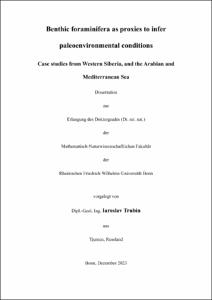Trubin, Iaroslav: Benthic foraminifera as proxies to infer paleoenvironmental conditions : Case studies from Western Siberia, and the Arabian and Mediterranean Sea. - Bonn, 2024. - Dissertation, Rheinische Friedrich-Wilhelms-Universität Bonn.
Online-Ausgabe in bonndoc: https://nbn-resolving.org/urn:nbn:de:hbz:5-74021
Online-Ausgabe in bonndoc: https://nbn-resolving.org/urn:nbn:de:hbz:5-74021
@phdthesis{handle:20.500.11811/11255,
urn: https://nbn-resolving.org/urn:nbn:de:hbz:5-74021,
author = {{Iaroslav Trubin}},
title = {Benthic foraminifera as proxies to infer paleoenvironmental conditions : Case studies from Western Siberia, and the Arabian and Mediterranean Sea},
school = {Rheinische Friedrich-Wilhelms-Universität Bonn},
year = 2024,
month = jan,
note = {Foraminifera are among the most important microfossils and invaluable tools for geosciences. Because of their small size and abundance, foraminifera are widely involved in applied studies where they are used for age-dating, correlation of sediments, and paleoenvironmental interpretations. Their mineralized shells record a wealth of information from the surrounding environment.
In this thesis, examples, and case studies on modern and fossil foraminifera from different environments are provided to illustrate and document how this group of organisms can be applied to infer environmental conditions of the past. The studies presented here cover wide ranges of environmental conditions from low latitude, warm and tropical environments to high latitude temperate and cold-water settings. The material investigated here includes material from the Paleocene and Eocene of Western Siberia, and modern foraminifera from the Mediterranean coast of Tunisia and from the coast of Oman. The habitats differ fundamentally in their nature and surrounding environmental conditions, and as such provide a multitude of information to interpret the fossil record.
The study location in Western Siberia is situated in a complex geological structure where the Peri-Tethys and the Arctic Ocean basins were connected through marine corridors. Benthic foraminiferal assemblages are widespread in this area, occur in a variety of habitats, and are of fundamental importance for paleoecological reconstructions. Paleogene drill cores were studied to shed new light on the evolution of the West Siberian ecosystems. This has been accomplished by compiling benthic foraminiferal inventories from drill sites, through careful taxonomical analysis, and by studying the structure and numerical parameters of benthic foraminiferal assemblages in relation to lithology, geochemical proxies, and paleoenvironmental indicators. To enable a detailed interpretation of past habitats, we applied actuopalaeontological approaches and compared the results with findings from modern marine ecosystems of the Arabian Sea and the Mediterranean Sea.},
url = {https://hdl.handle.net/20.500.11811/11255}
}
urn: https://nbn-resolving.org/urn:nbn:de:hbz:5-74021,
author = {{Iaroslav Trubin}},
title = {Benthic foraminifera as proxies to infer paleoenvironmental conditions : Case studies from Western Siberia, and the Arabian and Mediterranean Sea},
school = {Rheinische Friedrich-Wilhelms-Universität Bonn},
year = 2024,
month = jan,
note = {Foraminifera are among the most important microfossils and invaluable tools for geosciences. Because of their small size and abundance, foraminifera are widely involved in applied studies where they are used for age-dating, correlation of sediments, and paleoenvironmental interpretations. Their mineralized shells record a wealth of information from the surrounding environment.
In this thesis, examples, and case studies on modern and fossil foraminifera from different environments are provided to illustrate and document how this group of organisms can be applied to infer environmental conditions of the past. The studies presented here cover wide ranges of environmental conditions from low latitude, warm and tropical environments to high latitude temperate and cold-water settings. The material investigated here includes material from the Paleocene and Eocene of Western Siberia, and modern foraminifera from the Mediterranean coast of Tunisia and from the coast of Oman. The habitats differ fundamentally in their nature and surrounding environmental conditions, and as such provide a multitude of information to interpret the fossil record.
The study location in Western Siberia is situated in a complex geological structure where the Peri-Tethys and the Arctic Ocean basins were connected through marine corridors. Benthic foraminiferal assemblages are widespread in this area, occur in a variety of habitats, and are of fundamental importance for paleoecological reconstructions. Paleogene drill cores were studied to shed new light on the evolution of the West Siberian ecosystems. This has been accomplished by compiling benthic foraminiferal inventories from drill sites, through careful taxonomical analysis, and by studying the structure and numerical parameters of benthic foraminiferal assemblages in relation to lithology, geochemical proxies, and paleoenvironmental indicators. To enable a detailed interpretation of past habitats, we applied actuopalaeontological approaches and compared the results with findings from modern marine ecosystems of the Arabian Sea and the Mediterranean Sea.},
url = {https://hdl.handle.net/20.500.11811/11255}
}






